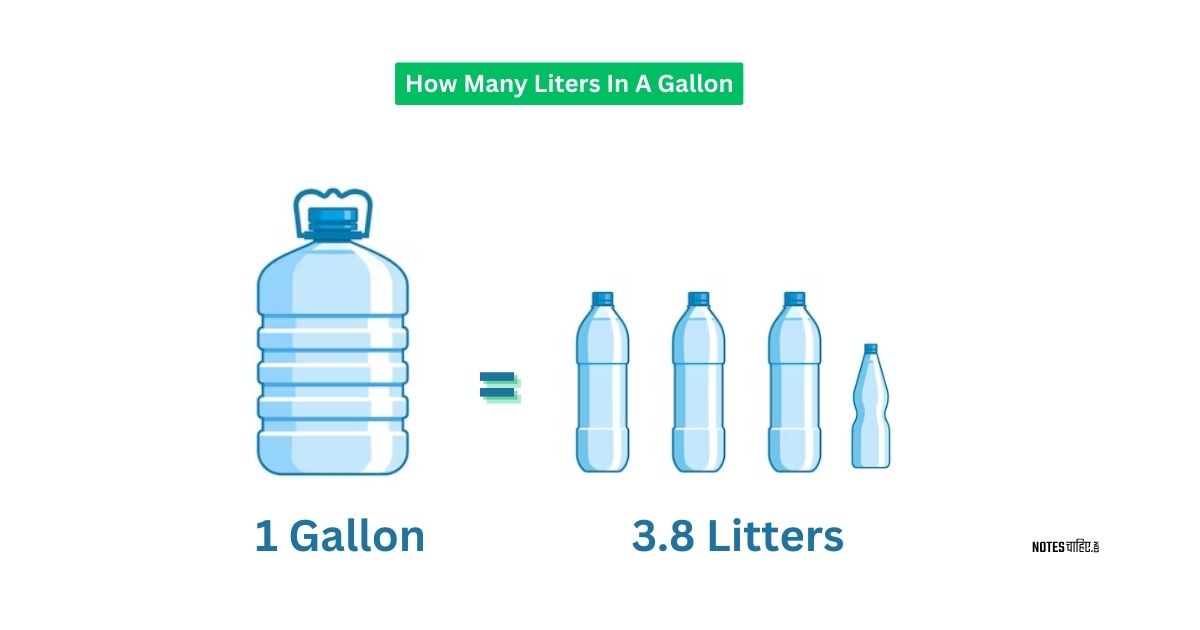How Many Liters In A Gallon: In our daily lives, we often encounter measurements of liquids in gallons and liters, with each unit serving its purpose in different parts of the world.
To simplify these conversions, a Gallon to Liter calculator is a handy tool, ensuring accuracy and efficiency.
In this guide, we will explore the relationship between gallons and liters, providing practical insights and a step-by-step conversion process.
Gallon To Liter Calculator
To make the conversion process seamless, a Gallon to Liter calculator is available online. By using this tool, you can easily convert the unit of weight of a liquid from gallons to liters.
How Many Ounces in a Cup? Conversions Calculator
The conversion is based on the straightforward relationship of 1 U.S. gallon being equivalent to 3.785411784 liters.
- Place the value of the volume in gallons into the provided input field on the calculator.
- Simply click on the “Convert” button to initiate the conversion process.
- The converted value of the volume in liters will appear in the output field, providing an instant and accurate result.
Gallon and Liter Basics
Before delving into the conversion, it’s essential to understand the origins of the gallon. The gallon is a unit of volume that dates back centuries and has roots in various cultures. The most common gallons used today are the imperial gallon and the U.S. gallon.
Gallon:
A gallon, commonly used in the United States, is a unit of volume mainly for larger containers. One U.S. gallon is equivalent to 231 cubic inches. The symbol for a gallon is “gal.”
Liter:
A liter, part of the International System of Units (SI), is a unit of volume equal to 1000 cubic centimeters or 1 cubic decimeter. It is widely used globally, not only for measuring liquid volume but also for indicating the capacity of various appliances. The symbol for a liter is “L.”
Conversion Factor: Gallons to Liters
To convert gallons to liters, we need to use the appropriate conversion factor. As mentioned earlier, there are different types of gallons, and each has its conversion factor to liters.
Imperial Gallon to Liters:
To convert imperial gallons to liters, you can use the conversion factor 4.54609. Simply multiply the number of gallons by this factor to obtain the equivalent volume in liters.
Example:
Liters=Imperial Gallons×4.54609
U.S. Gallon to Liters:
For U.S. gallons, the conversion factor is 3.78541. Multiply the number of U.S. gallons by this factor to get the volume in liters.
Example:
Liters=U.S. Gallons×3.78541
Gallon to Liter Conversion Table
For a quick reference, here is a conversion table illustrating the relationship between gallons and liters:
| Gallon (gal) | Liter (L) |
|---|---|
| 1 | 3.78541 |
| 2 | 7.57082 |
| 3 | 11.3562 |
| 4 | 15.1416 |
| 5 | 18.9271 |
| 6 | 22.7125 |
| 7 | 26.4979 |
| 8 | 30.2833 |
| 9 | 34.0687 |
| 10 | 37.8541 |
| 20 | 75.7082 |
| 50 | 189.271 |
| 100 | 378.541 |
Practical Examples
Let’s work through a few practical examples to illustrate the conversion process.
Example 1:
If you have 2 imperial gallons of water, how many liters is that?
Liters=2 Imperial Gallons×4.54609
Liters=9.09218 Liters
So, 2 imperial gallons is equivalent to approximately 9.09 liters.
Example 2:
You have 3 U.S. gallons of paint. How many liters is that?
U.S. Gallons×3.78541 Liters
Liters=11.35623
Therefore, 3 U.S. gallons is equal to approximately 11.36 liters.
FAQs Gallon to Liter
The value of 1 gallon to liter is 3.78541.
One gallon of volume is equal to 3785.41 milliliters.
One gallon is equal to 3.78541 L, so half a gallon is 1.89271 L.
One gallon is equal to 3.78541 L, so one-fourth of a gallon is 0.9463529 L.
Three-fourth gallon equals 2.839059 liters.
Conclusion:
Understanding the conversion between gallons and liters is not only essential for practical purposes but can also be made simpler with the help of online calculators.
By grasping the relationships and using the provided conversion factors, you can confidently navigate between these units, ensuring accuracy in various applications, from cooking to industrial settings.


Leave a Reply